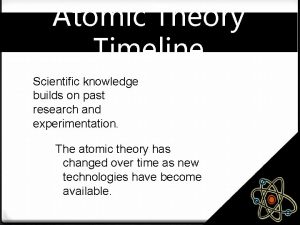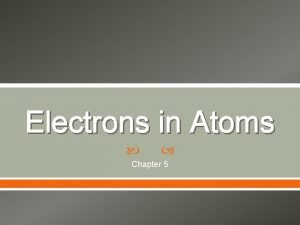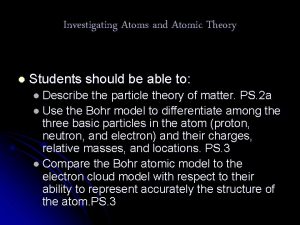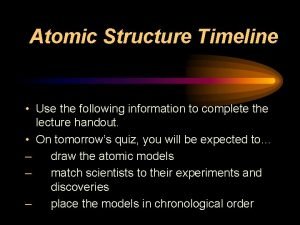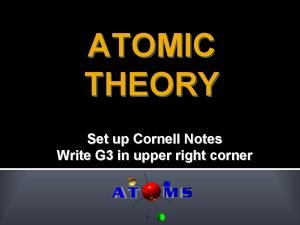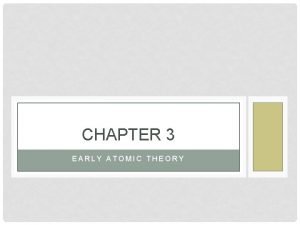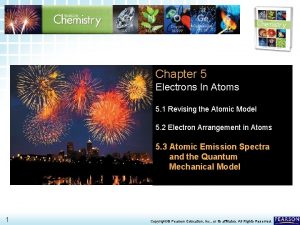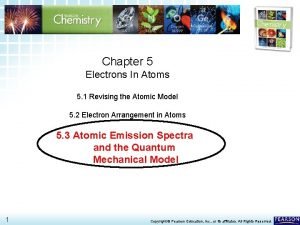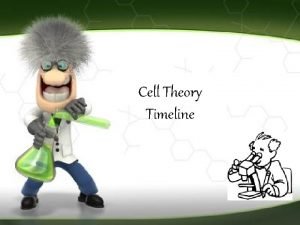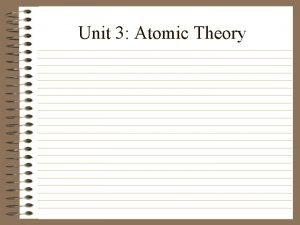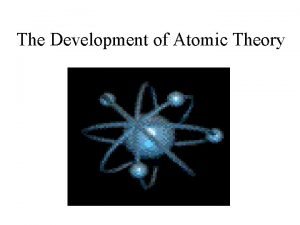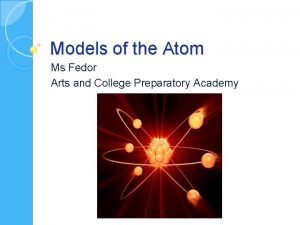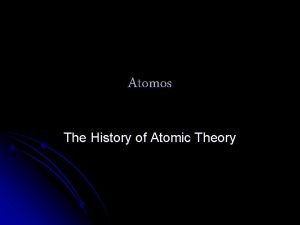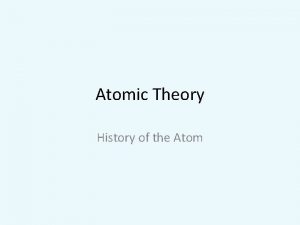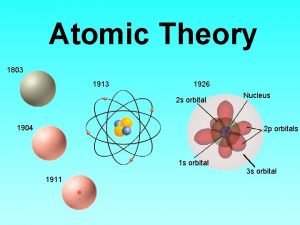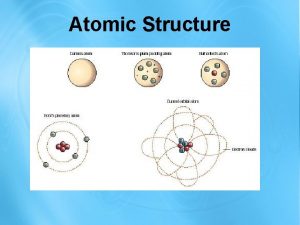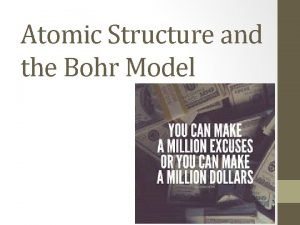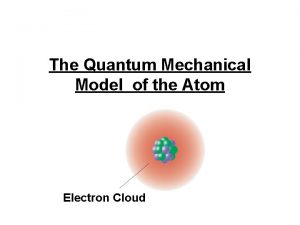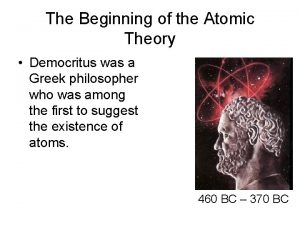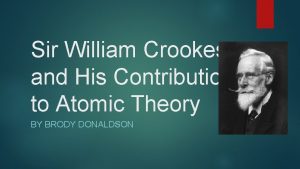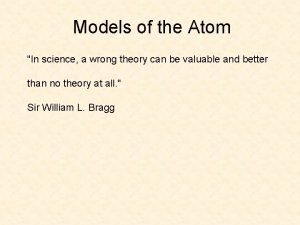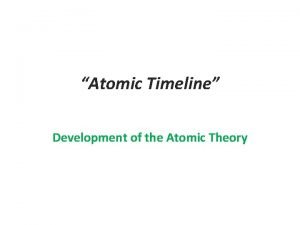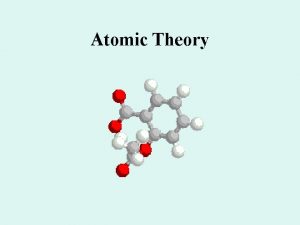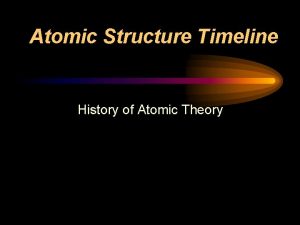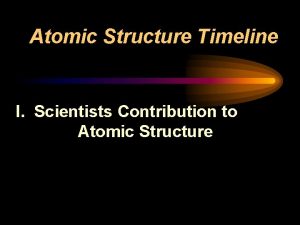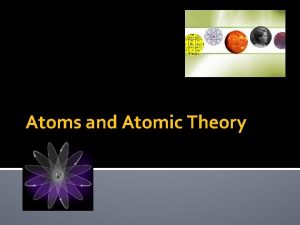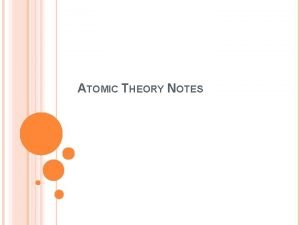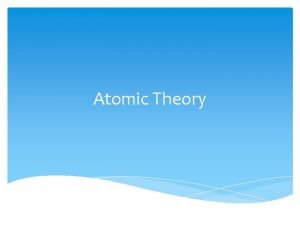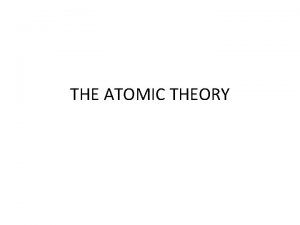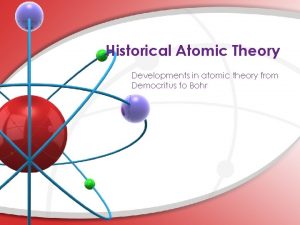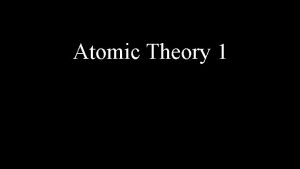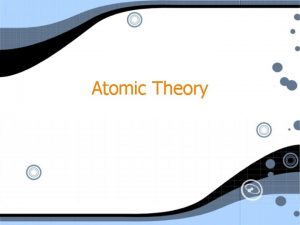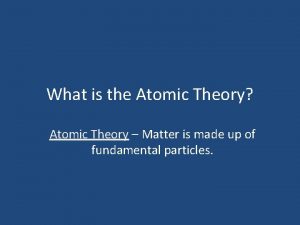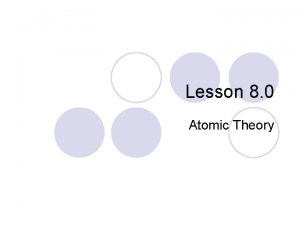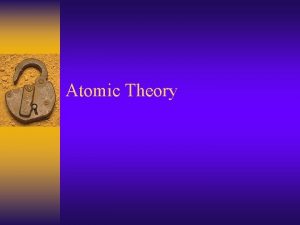Atomic Theory Timeline Model and Theory l A






























- Slides: 30

Atomic Theory Timeline

Model and Theory l A theory is a set of statements that is developed through a process of continued abstractions. A theory is a generalized statement aimed at explaining a phenomenon. l A model, on the other hand, is a purposeful representation of reality.

Theory l In everyday usage, “theory” often refers to a hunch or a speculation. When people say, “I have a theory about why that happened, ” they are often drawing a conclusion based on partial or inconclusive evidence. Scientists have hunches, too, but they call them hypotheses, which are the starting point of all good science.

Scientific theory l A scientific definition of theory is quite different from the everyday meaning of the word. A scientific theory refers to a comprehensive explanation of some aspect of nature that unifies a vast body of reliable knowledge. In other words, a theory is born when a substantial number of hypotheses point to the same conclusion

Who are these men? In this lesson, we’ll learn about the men whose quests for knowledge about the fundamental nature of the universe helped define our views.

Democritus l This is the Greek philosopher Democritus who began the search for a description of matter more than 2400 years ago. l He asked: Could matter be divided into smaller and smaller pieces forever, or was there a limit to the number of times a piece of matter could be divided? 400 BC

Democritus l l l His theory: Matter could not be divided into smaller and smaller pieces forever, eventually the smallest possible piece would be obtained. This piece would be indivisible. He named the smallest piece of matter “atomos, ” meaning “not to be cut. ”

Atomos § § To Democritus, atoms were small, hard particles that were all made of the same material but were different shapes and sizes. Atoms were infinite in number, always moving and capable of joining together.

This theory was ignored and forgotten for more than 2000 years!

Why? l The eminent philosophers of the time, Aristotle and Plato, had a more respected, (and ultimately wrong) theory. Aristotle and Plato favored the earth, fire, air and water approach to the nature of matter. Their ideas held sway because of their eminence as philosophers. The atomos idea was buried for approximately 2000 years.


Dalton’s Model l In the early 1800 s, the English Chemist John Dalton performed a number of experiments that eventually led to the acceptance of the idea of atoms.

Dalton’s Theory l l He deduced that all elements are composed of atoms. Atoms are indivisible and indestructible particles. Atoms of the same element are exactly alike. Atoms of different elements are different. Compounds are formed by the joining of atoms of two or more elements.

. l This theory became one of the foundations of modern chemistry.

Thomson’s Plum Pudding Model l In 1897, the English scientist J. J. Thomson provided the first hint that an atom is made of even smaller particles.

Thomson Model He proposed a model of the atom that is sometimes called the “Plum Pudding” model. l Atoms were made from a positively charged substance with negatively charged electrons scattered about, like raisins in a pudding. l

Thomson Model l Thomson studied the passage of an electric current through a gas. l As the current passed through the gas, it gave off rays of negatively charged particles.

Thomson Model l This surprised Thomson, because the atoms of the gas were uncharged. Where had the negative charges come from? Where did they come from?

Thomson concluded that the negative charges came from within the atom. A particle smaller than an atom had to exist. The atom was divisible! Thomson called the negatively charged “corpuscles, ” today known as electrons. Since the gas was known to be neutral, having no charge, he reasoned that there must be positively charged particles in the atom. But he could never find them.

Rutherford’s Gold Foil Experiment l In 1908, the English physicist Ernest Rutherford was hard at work on an experiment that seemed to have little to do with unraveling the mysteries of the atomic structure.

l Rutherford’s experiment Involved firing a stream of tiny positively charged particles at a thin sheet of gold foil (2000 atoms thick)

Most of the positively charged “bullets” passed right through the gold atoms in the sheet of gold foil without changing course at all. l Some of the positively charged “bullets, ” however, did bounce away from the gold sheet as if they had hit something solid. He knew that positive charges repel positive charges. l


l http: //chemmovies. unl. edu/Chem. Anime/R UTHERFD/RUTHERFD. html

l l This could only mean that the gold atoms in the sheet were mostly open space. Atoms were not a pudding filled with a positively charged material. Rutherford concluded that an atom had a small, dense, positively charged center that repelled his positively charged “bullets. ” He called the center of the atom the “nucleus” The nucleus is tiny compared to the atom as a whole.

Rutherford l Rutherford reasoned that all of an atom’s positively charged particles were contained in the nucleus. The negatively charged particles were scattered outside the nucleus around the atom’s edge.

Bohr Model l In 1913, the Danish scientist Niels Bohr proposed an improvement. In his model, he placed each electron in a specific energy level.

Bohr Model l According to Bohr’s atomic model, electrons move in definite orbits around the nucleus, much like planets circle the sun. These orbits, or energy levels, are located at certain distances from the nucleus.

Electron Cloud: l l A space in which electrons are likely to be found. Electrons whirl about the nucleus billions of times in one second They are not moving around in random patterns. Location of electrons depends upon how much energy the electron has.

Electron Cloud: l l l Depending on their energy they are locked into a certain area in the cloud. Electrons with the lowest energy are found in the energy level closest to the nucleus Electrons with the highest energy are found in the outermost energy levels, farther from the nucleus.
 Aristotle atomic
Aristotle atomic Democritus atomic model diagram
Democritus atomic model diagram Atomic theory timeline
Atomic theory timelineHenry moseley atomic theory timeline
 Relative atomic mass of beryllium
Relative atomic mass of beryllium O
O Whats the difference between atomic mass and atomic number
Whats the difference between atomic mass and atomic number What are the trends in periodic table
What are the trends in periodic table نصف القطر الذري
نصف القطر الذري Atomic number vs atomic radius
Atomic number vs atomic radius Atomic timeline
Atomic timeline Atomic model schrodinger
Atomic model schrodinger Atomic timeline
Atomic timeline Milikan model
Milikan model Atomic emission spectra and the quantum mechanical model
Atomic emission spectra and the quantum mechanical model Atomic emmision spectrum
Atomic emmision spectrum Hans and zacharias janssen cell theory date
Hans and zacharias janssen cell theory date Robert millikan atomic model
Robert millikan atomic model Robert millikan atomic model
Robert millikan atomic model Chadwick atomic model
Chadwick atomic model John daltons atom
John daltons atom Atomos atomic model
Atomos atomic model History of atom models
History of atom models 1926 atomic theory
1926 atomic theory Atomic model evolution
Atomic model evolution Bohr model of krypton
Bohr model of krypton Quantum mechanical model of the atom
Quantum mechanical model of the atom Democritus model of atom
Democritus model of atom William crookes atomic theory date
William crookes atomic theory date Erwin schrödinger atomic theory
Erwin schrödinger atomic theory Bohr rutherford calcium
Bohr rutherford calcium

